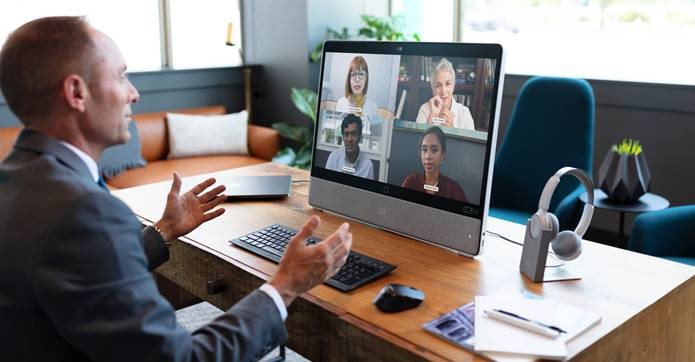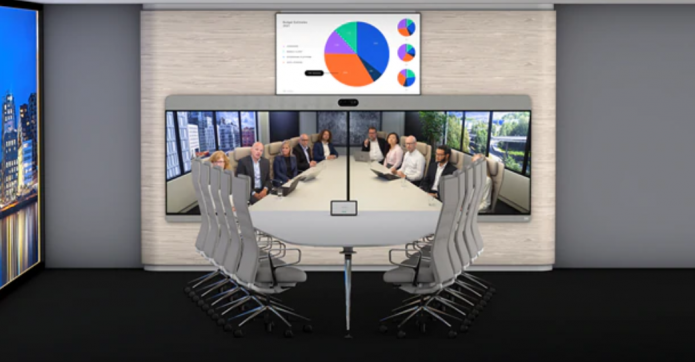
Company-Specific Updates
During our 4-days in Amsterdam, we participated in > 40 meetings and supported numerous client events. Once again, please understand that we can’t cover everything we saw. There just isn’t enough room on the page or time in the day.
This ISE coverage note (part 2 of 3) covers vendors from the first part of the alphabet.
In addition to the news of the pending merger with Whitlock, at the ISE event, AVI-SPL demonstrated a plethora of new capabilities within its Symphony AV, VC, and UC monitoring and management platform.
A week before ISE, AVI-SPL released Symphony version 4.9. New capabilities available within 4.9 include the ability to import information about devices, rooms, and locations from a spreadsheet, support for mass changes prior to import and mass updates after import, and more. This new version also brings a redesigned Room Details view including favorites, sliders, drop-downs, and more. Summary – version 4.9 is about streamlining the user workflow and improving the UI. As I said, most vendors are in a “shoring-up” phase with their offerings. AVI-SPL is no exception.At ISE, AVI-SPL introduced the Symphony Adapter Marketplace. The marketplace expands the roster of AV and UC devices that can be monitored and controlled through symphony.
Symphony Adapter Marketplace is basically a library of plug-ins, some created by AVI-SPL and some created / to-be-created by others, that add specific new capabilities to the Symphony platform. Some plug-ins add specific device capabilities (e.g. monitor this display), while others bring system-wide functionality (e.g. integration with ticketing systems and cloud service applications).
According to the company, Symphony already integrates / supports products from Biamp, Cisco, Crestron, LG, Lenovo, Logitech, Middle Atlantic, NEC, Netgear, Poly, Samsung, SurgeX, and more.

The ability to control so many devices gives Symphony the ability to support some interesting use cases. For example, if a device isn’t responding or performing properly, Symphony can force a reboot of the device by controlling the power distribution unit (PDU) that is actually powering the device. Similarly, Symphony can force a reboot by telling the Netgear switch providing PoE power to a device to turn off PoE power to that device for a few seconds. In a world where a single device can mean the difference between a successful and failed meeting, this is a big deal.
Finally, the Symphony demo we had on the show floor was impressive.
Our ISE meeting with Barco was all about ClickShare Conference (CC), the company’s newly released product that allows users to host collaboration sessions from their laptops wirelessly (without having to connect USB or HDMI cables).
Barco first announced CC during a press event in New York in late January, but ISE was our first chance to see the system – and specifically the workflow and user experience – up-close and personal.
Knowing Barco as we do, we were not concerned that CC would perform as specified. Our questions focused on one specific element – the ability for additional participants in the meeting room to share content through ClickShare Conference.
During the demo, we learned that ClickShare Conference creates a virtual second display on the user’s laptop hosting the meeting. This virtual display then receives a stream of the content visible on the main screen, and then sends that content to the collaboration app (e.g. Zoom, Teams, Cisco Webex, etc.). This is configured using the ClickShare Conference app installed on the host laptop.
For more information, please read our Research Note on ClickShare Conference.

At ISE, Biamp launched Crowd Mics Online, an extension of the previously released Crowd Mics solution (allows event participants to use their smartphone as a personal microphone and interactive response system using a free iOS or Android app) that also supports remote audiences. We liked the idea of Crowd Mics when it was announced in 2019. The ability to use Crowd Mics with remote participants makes it that much better.
In addition, Biamp also launched the TEC-X family of networked wall and table controllers. The most common use case for the TEC-X controllers will be to control volume levels and source selection. However, programmers can also use TEC-X for other purposes (e.g. acting as the UI for AV systems in meeting rooms and other spaces).
Biamp also announced a new member of the TesiraCONNECT line – the TC-5D. The TC-5D is a dual-network device that allows the use of both AVB and Dante devices in AV solutions. Today, AV is all about flexibility, and the TC-5D brings digital audio flexibility to the table. What’s not to like?
Finally (at least as far as our coverage of Biamp here), Biamp announced its intent to acquire Huddle Room Technology (HRT) SRL, a technology company based in Modena, Italy. HRT’s main (if not only) products is the Huddle Hub, an innovative solution that allows computers and mobile devices to connect to USB room peripherals such as displays, speakers, mics, and cameras wirelessly. This allows users to display content, launch apps, and use their laptop to host video meetings without the hassle of connecting HDMI and USB cables.

We’ve covered HRT for many years, and we watched the company shift its focus from offering a meeting hub that allows multiple local participants to participate in meetings using their laptops, to offering a wireless USB gateway offering.
Quite frankly, while we appreciated the concept and feel of the prior use case, we aren’t surprised by the slow uptake. The market just wasn’t ready for meeting room meetings without a shared display. This solution was before its time.
The new Huddle Hub use case is far easier to understand. USB connectivity without USB cables. Yep – we get that.

The combination of HRT’s technology and Biamp’s brand, reputation, and reach should pave the way for additional sales.
Note that HRT (Biamp) is now one of four players offering wireless USB. The others are Barco with ClickShare Conference, Kramer with some models of Via (e.g. Via Connect Plus), and Mersive with Solstice. At least Biamp is in pretty good company.
At the ISE event, Bose announced the Bose Videobar VB1 – an all-in-one USB conferencing device that according to the company brings premium audio and video to small meeting areas – from huddle spaces to medium-sized rooms.
The VB1 includes:
- Six beam-steering microphones that automatically focus on voices in the room and reject noise
- A 4K camera with auto-framing for people, whiteboards, flipcharts and other in-room objects
- Bluetooth connectivity for stand-alone speakerphone operation
- Management and control using the Bose Work Management app

The VB1 will be sold through a network of Bose Professional partners for an MSRP of US $1,199 or €1,199.
Truth be told, we saw an early version of the VB1 in mid-2019, so this release was hardly a surprise.
It’s always hard to test an audio product on a show floor. Fortunately, we had some hands-on time the day before ISE at the Bose HQ. Although we haven’t formally tested the VB1 yet, the demo was quite impressive. We especially liked the quality of the sound provided by the VB1’s built-in amplifier and speakers. But hey – this is right up Bose’s alley.
We hope to release a formal evaluation report on the VB1 in the near future.
As an aside, we are very pleased to see Bose enter the huddle room market. For far too long, Bose products have been relegated to the expensive, fully-integrated meeting spaces. With the VB1, Bose hopes to change all that.
It is, however, worth noting that Bose is a bit late to the party here. The USB all-in-one market is already crowded with vendors including Logitech, Cisco, Poly, Yamaha, and others.
But we wouldn’t count Bose out quite yet. The company’s brand and reputation bring quite a bit of muscle to discussion, and the device’s performance will likely not disappoint. Finally, there are ~ 40M small meeting rooms out there, the majority of which are not yet video-enabled. In other words, there’s more than enough opportunity out there for all of these vendors.
The real question is how aggressively Bose will market the VB1. That will likely determine whether Bose’s entry into the lower-end of the market is a success or a flop.
For Cisco, ISE 2020 was about partnerships. In particular, Cisco highlighted its recently inked partnership with Samsung by demoing several joint offerings including “Webex on Flip,” which is essentially a Cisco Webex Room Kit Mini bundled with (and installed just above) Samsung’s 2nd generation Flip (Flip 2) device.
Cisco also demo’d its latest and greatest immersive telepresence system, Webex Room Panorama. Some (including us) might say that the immersive telepresence market is barely surviving on life support, but that doesn’t mean there isn’t some money to be made.
Webex Room Panorama offers a two-screen wide immersive experience, but notably uses only a single codec. As a result, it doesn’t quite fit into the multi-codec product category that our analysts defined more than a decade ago.

In addition, unlike prior Cisco immersive telepresence offerings, Panorama does NOT include the meeting room furniture; a change we view as VERY good news. Cisco is not a furniture company and thus should not require customers to buy specific furniture for their meeting rooms.
Final note – Panorama uses Samsung 82-inch 8K QLED displays. WAY COOL! Small request to Cisco — please send a few displays our way when time permits. 😊


Additionally, ISE marked the first time Cisco publicly displayed and demo’d its new Webex Desk Pro product. Desk Pro is an all-in-one personal video conferencing device sporting a 27-inch 4K multi-touch display.
As Henry David Thoreau said in Walden, “Simplify … simplify … simplify.” UK-based DisplayNote really took Thoreau’s words to heart.
DisplayNote is (or at least was) a longstanding provider of wireless presentation, screen-sharing, collaborative learning, and advanced collaboration (a.k.a. ideation, e-whiteboarding, etc.) solutions.
The company’s solutions have been pre-loaded onto thousands of PCs and touch display sold around the globe, and DisplayNote’s customer roster includes companies like Dell, Deloitte, Fujitsu, Heineken, NEC, Vodafone, and more.
At ISE, we learned that DisplayNote is now focused on one key application – the DisplayNote Launcher. This means they consolidated their development, sales, and support efforts from covering six offerings to just one.
DisplayNote Launcher is a software application that provides users with quick access to the collaboration applications, calendar, and services installed on a shared meeting room PC.

The concept here is simple — allow meeting room users to easily choose between and participate in meetings using multiple collaboration apps (e.g. Cisco Webex, Microsoft Teams, Zoom, etc.) installed on the same meeting room PC or intelligent display.
Key features of Launcher include “room reset” to clear the device of cached data, one-touch join into the most popular conferencing services, authentication with your mobile device, and Microsoft Exchange integration.
According to the company, Launcher is available for a list price of $395 per room per year, with a $100 upcharge for added wireless presentation capability.
DisplayNote is not the first to offer a launcher product. In fact, our team has tested at least a half a dozen such offerings. But DisplayNote has the right idea — keep it simple. Cover the core requirement. And price it right – on a per-room basis.
Tucked away in Crestron’s booth we found Domotz. Wait, in the Crestron booth? Yes. That Crestron.
In May of 2019, Crestron and Domotz announced a partnership focused primarily on the residential space. This partnership is aimed at system integrators servicing smart homes, and provides these providers with a cloud-based portal to remotely monitor and manage residential customer systems.
Domotz, however, is focused on the IoT space, offering cost-effective device monitoring, management, and control to small, medium, and large customers around the world.
Domotz uses a lightweight agent installed on the customer’s network to capture device information and send it to its cloud portal.
We are intrigued by Domotz for a number of reasons:
- The price-is-right! For ~ $20 / month, administrators can remotely monitor and manage up to 1,024 devices on a single VLAN / subnet. So the cost per device is just a few pennies per month. This is the kind of pricing that drives large-scale connectivity (think IoT – not traditional AV).
- The web-based portal, by way of the onsite agent, allows for remote control of devices. Need to reboot a device connected to an APC power distribution unit? Hit the Domotz portal. Need to change a setting on a codec? Hit the Domotz portal. Get the idea?

In the DTEN booth, which also happened to be Zoom’s main booth at the show (read into that as you wish), we saw an interesting, soon-to-be-released product, the DTEN GO.
DTEN GO is a Zoom-powered video appliance (meaning it boots up to a Zoom Rooms experience) that includes a 12-mic array that purportedly captures audio at distances up to 20 meters, and four built-in cameras offering a combined field of view of 160 degrees.
Unlike DTEN’s existing products, the D7 and D10 display-based Zoom video systems, DTEN GO is a “bring your own display” offering.
DTEN also showed DTEN Mate, a wireless tablet controller that acts as the DTEN GO UI (launch calls, adjust volume, etc.), but also acts as a touch collaboration interface enabling digital inking on non-touch-enabled displays.

The DTEN GO & MATE package are expected to ship in the late April 2020 timeframe for a list price of US $999. And although most of the company’s current revenue comes via channel partners, the DTEN GO & MATE package can be purchased by customers directly on the DTEN website.
Given the specs and price point of this bundle, we’re quite eager to take it for a spin.
Finally, DTEN’s executives made a point of saying that DTEN is not a hardware company or software company. DTEN considers itself an AI company, although they admit that the current crop of products offers limited AI capabilities. Hmmm. For now at least, we will let that one slide. But if nothing else, DTEN becomes more interesting every time we see them.
At the ISE event, Kramer extended its wireless presentation portfolio with the release of Via Go2. Via Go2 offers the same basic features found on the rest of the Via platform, plus support for high frame rate 4K video.
In addition, the device’s small form factor makes it easy to hide it within the meeting room. For example, the Via Go2 can sit quite happily on top of a project or behind a display.
Despite the reduced attendance, the Logitech booth was bustling throughout the event.
Logitech’s ISE announcements focused on new strategic partnerships including:
- On February 10th, Crestron and Logitech announced the “meet in the market” partnership described in Part 1 of our ISE Round-Up and in our video covering this partnership.
- On February 11th, Logitech and Barco announced the Logitech Rooms Solutions for Barco ClickShare Conference. These are joint, all-in-one solutions featuring a Logitech MeetUp or Rally solution paired with a Barco ClickShare Conference.

In many ways, this is a match made in heaven. Logitech offers a strong portfolio of USB camera / mic / speaker solutions (we refer to these solutions as group add-on solutions), and Barco ClickShare Conference offers wireless USB connectivity.
On the surface, this may not seem like a major announcement. After all, ClickShare Conference can – in theory – be used with any USB peripherals. Remember, however, that Barco has shipped more than 750,000 ClickShare units since the products inception. If just 5% of the existing base upgrade to a Barco / Logitech bundle, that represents tens of thousands of units (and tens of millions of dollars of revenue) for Logitech.
- Also on February 11, Logitech announced a partnership with Lenovo to create a new bundle including Logitech Tap, a Lenovo ThinkSmart Edition M920 Tiny PC pre-loaded with Microsoft Teams Rooms or Zoom Rooms software, and Logitech Rally.
This partnership means that Lenovo, and its massive global sales force, can now offer Logitech solutions to Lenovo’s enterprise customers. This also means that end-user organizations that have standardized on Lenovo compute can stay “on brand” and buy turnkey video conferencing bundles. Pricing will start at $2,099 for the Zoom Rooms bundle and $2,149 for the Microsoft Teams bundle.




















